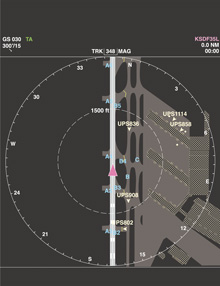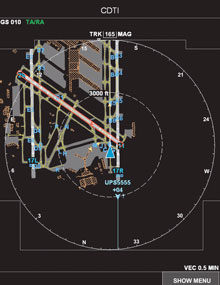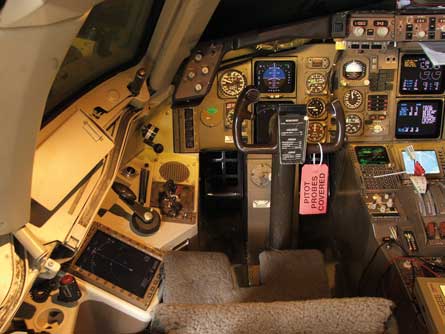Since two Boeing 747s collided at Tenerife 30 years ago there have been several deadly runway collisions, and incursions continue at an unacceptable rate. Incursion prevention is on the US National Transportation Safety Board's "red" list of urgent priorities, and the Federal Aviation Administration is seeking solutions.
Several incursion incident reports highlight loss of positional awareness as a causal factor, and GPS data combined with on-board airfield databases can provide aircrew with a graphical depiction of their "own-ship" position.
Just such a tool, surface area movement and management (SAMM), is provided by the SafeRoute system developed by L-3 Communications and Thales company ACSS and based on automatic dependent surveillance - broadcast. It is one four tools provided by SafeRoute, including cockpit display of traffic information (CDTI), merger and spacing (M&S) and CDTI-assisted visual separation (CAVS).
| |
|---|
In UPS's 757, SafeRoute functions are hosted on sidewall-mounted class 3 EFB displays |
ADS-B exploits the capability of today's Mode S transponders to automatically broadcast an "extended squitter" containing aircraft altitude, rate of altitude change, position, heading and velocity. Cargo carrier UPS Airlines has played a key role in championing the technology, originally pursuing development of an ADS-B-based collision-avoidance system as an alternative to TCAS. Ultimately the system was not fielded, but UPS continued to believe in the underlying technology.
ACSS, meanwhile, saw the potential of ADS-B and two years ago launched development of SafeRoute. UPS is the launch customer, and plans to equip its 757, 767 and 747-400 freighter fleets by the end of 2008, and has provided a 757 for the certification effort.
TAXI EXERCISE
In June, after pre-certification testing was completed, Flight International travelled to UPS's hub in Louisville, Kentucky to see SafeRoute in action. A 1.5h airfield taxi exercise demonstrated the SafeRoute tools.
On the testbed 757-200PF (N401UP), the system is hosted in the class 3 electronic flight bag. There are two EFB displays, one on each side panel below the cockpit sliding windows, the 7 x 9in (175 x 225mm) colour screens angled upward to facilitate viewing.
  | |
Own-ship position is shown on the airport diagram as a triangle. Red highlights an incursion threat, as target (red chevron) moves down the runway | |
The first tool examined was CDTI. Own-ship position is depicted by an arrowhead on the display, which has both compass rose and arc formats with range scales from 500m (1,500ft) to 550km (300nm). The EFB showed all transponder returns, duplicating the TCAS display on the centre console. Symbology for TCAS-generated targets is the same on both displays. ADS-B "out" targets, those squittering, were also displayed on the CDTI, but with their own unique symbology.
Ground targets are brown while airborne ones are cyan. Currently ground ADS-B targets are shown on the CDTI when own-ship altitude is less than 1,500ft AGL. A stationary target is shown as a diamond. Moving targets with low positional accuracy are represented by a bullet, those with high accuracy by a chevron. ADS-B targets are drawn on the CDTI based on their broadcast GPS position, which is more accurate than TCAS.
As we taxied, several interesting points became apparent. Since transponders are generally not turned on until ready for take-off and turned off immediately after landing, TCAS targets were generated only for airborne aircraft. ADS-B returns for both ground and air targets were presented since it is an automatic system. At airports that require the transponder to be on at all times when moving on the airfield, TCAS ground targets would be seen.
The accuracy of ADS-B versus TCAS was also clear. TCAS returns from landing aircraft were frequently displaced laterally from the displayed runway centreline. ADS-B returns showed the landing aircraft on the displayed centreline. At all times our own-ship position was accurately depicted on the CDTI.
Next was merger and spacing. The efficiency of continuous descent arrival (CDA) procedures has been demonstrated in several trials including UPS's own in 2004, which showed reductions in NOx emissions of 34% below 3,000ft, up to 6dB in noise and 115-210kg (250-465lb) in fuel per approach, depending on aircraft type. While CDAs can be executed without SafeRoute, its accurate relative position data allows for compact aircraft spacing in the approach stream.
In M&S, buttons on the EFB bezel are used to step a circular "halo" between displayed ADS-B targets until the aircraft to be followed is captured. The desired spacing time interval is entered using pull-down menus. The left window on the ADS-B guidance display (AGD) panel, mounted below the glareshield on the captain's side, then shows the speed needed to attain and maintain the desired interval. The centre window shows differential ground speed between own ship and coupled target. The right window shows distance to target. When airborne the AGD is the primary reference for maintaining desired spacing.
SEPARATION INTERVALS
Required ATC separation intervals are unchanged, but the M&S tool should reduce and nearly eliminate additional spacing required by controllers to manage the dynamic ebb and flow of an arrival stream. Combined with CDA procedures, M&S promises to reduce controller workload, fuel consumption and environmental impact while increasing airport capacity.
SafeRoute's CAVS tool, meanwhile, is a knock-on benefit of CDTI. Visual arrival streams can be more tightly spaced than instrument arrivals, increasing airport capacity, but visual approaches to the same runway generally require the preceding aircraft be kept in sight. In reduced visibility the CDTI can help in two ways. First the accurate position display may help pilots visually acquire the traffic they are to follow. Second and perhaps more innovative is to allow the following aircraft to assume responsibility for its own separation from the preceding aircraft based purely on the CDTI. With appropriate aircrew procedures and agreements with ATC, the CAVS tool may increase arrival rates in degraded conditions.
While the previous three tools focus on the airborne environment, the surface area movement manager promises to reduce runway incursions. A recent Joint Safety Implementation Team study determined 95% of runway incursions could be prevented if airfield position and opposing traffic were displayed to crews. SAMM's airfield diagram depicting own-ship position and ADS-B ground targets should enhance the aircrew's situational awareness and alert them to developing conflicts.
For SafeRoute to provide accurate position and vector information, opposing traffic needs to be squittering ADS-B data, and while the SAMM function is ready to reduce runway incursions it will take several years for all aircraft to be equipped with ADS-B "out". Additionally, the algorithms and operational rules for automatic conflict advisories and resolutions are in early development.
But for an operator like UPS that represents a large percentage of the traffic at a particular airport, SafeRoute can provide immediate benefit, says ACSS. As UPS gains experience, other operators will no doubt take a closer look.
Can the numbers of runway incursions ever be reduced? To learn more about US incidents visit flightglobal.com/incursions
Source: Flight International
























